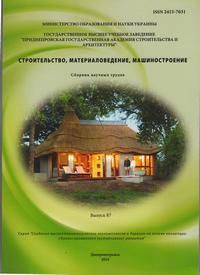Modern methods of progressive collapse simulation of building and structures
Keywords:
progressive collapse, vitality, steel frames, structural safety, software complexes.Abstract
The progressive collapse estimation and the ways of their prevention are highly depends on the decisions of the failure criteria of elements and based on the calculation methods. The aim of the article is to cover issues of progressive collapse modeling using modern software systems, estimation of their failure criteria, comparison and identification of features taking into account the possibility of their use in solving various tasks classes. The main objectives of the study is to examine the criteria of element failures in emergencies used in a variety of software systems; comparative calculation of the steel frame with single element failure; assessment of the possibility of using different approaches and software systems in the structural safety analysis of buildings and structures. Methods. Methodology of the tasks solving is based on the numerical studies of steel frame after one column failure calculated using SAP2000 software systems and Extreme Loading for Structures (ELS). Results. The analysis of elements nonlinear behavior and criteria for their failure in emergency situations calculated using two different software systems are showed. This article shows a comparative analysis of the progressive collapse scenarios of the steel frame derived from non-linear analysis using various modeling methods. The studies indicate the convergence of various software systems using for progressive collapse scenarios search. Scientific novelty. The different software systems and their methods of calculation buildings and structures in emergency situations were studied. The software selection criteria of the application for solving various tasks classes were obtained. These criteria are associated with the analysis of the structural safety of existing and new buildings. The practical significance. Examination of the various progressive collapse modeling methods of buildings and structures opens the way to a better understanding of a ensuring important building objects vitality problems and makes possible to create a rational design solutions to protect buildings against progressive collapse. These results allow us to make an informed decision about application of software complexes depending on the purpose of the calculation.
References
Bilyk A.S., Kovalenko А.I. Porivnjannja metodiv rozrakhunku metalevykh karkasiv vysotnykh budivelj na odynychnu zhyvuchistj [Comparison of calculations of high-rise metal frame buildings with single vitality]. Zbirnyk naukovykh pracj Ukrajinsjkogho instytutu stalevykh konstrukcij imeni V.M. Shymanovsjkogho - Kiev [Collected Works of the Institute of Ukrainian steel structures of V.M. Shymanovski - Kiev]. 2015 – no. 16, –pp. 73-78 (in Ukranian).
Minregion Ukrainy. Zaghaljni pryncypy zabezpechennja nadijnosti ta konstruktyvnoji bezpeky budivelj, sporud, budiveljnykh konstrukcij ta osnov : DBN V.1.2-14:2009 [State standard of Ukraine V.1.2-14:2009. General principles of reliability and structural safety of buildings, structures and foundations]. Kyiv, 2009, 43 p. (in Ukranian).
Minregion Ukrainy. Proektuvannja vysotnykh zhytlovykh i ghromadsjkykh budynkiv : DBN V.2.2-24:2009 [State standard of Ukraine V.2.2-24:2009. Design of high-rise residential and public buildings]. Kyiv, 2009, 155 p. (in Ukranian). 4. Jinkoo Kim, Taewan Kim. Assessment of progressive collapse capacity of steel moment frames. Journal of Constructional Steel Research, 2009, №65, pp. 169–179.
J. Fogarty, N.M. Yossel, S. El-Tawil. Collapse resistance of locally damaged steel columns. Journal of Constructional Steel Research, 2013, №82, pp. 195–202.
USA, Department of Defense. Design of Buildings to Resist Progressive Collapse: UFC 4-023-03, 2009, 245 p. – (USA Standard).
Khaled Galal, Tamer El-Sawy. Effect of retrofit strategies on mitigating progressive collapse of steel frame structures. Journal of Constructional Steel Research, 2010, №66, pp. 520–531.
Hatem Tagel-Din. High Fidelity Modeling of Building Collapse with Realistic Visualization of Resulting Damage and Debris Using the Applied Element Method, 2009, 135 p. – (Applied Science International).
American Society of Civil Engineers. Minimum Design Loads for Buildings and Other Structures. Reston, USA, 2010, 658 p. – (American Society of Civil Engineers). – (ISBN; № 2147483647)
National Research Council of Canada. National Building Code of Canada. Ottawa, Canada, 2010, 1222 p. – (Canada Standard).
J.L. Liu. Preventing progressive collapse through strengthening beam-to-column connection. Journal of Constructional Steel Research, 2010, №66, pp. 229–237.
Progressive Collapse Analysis and Design Guidelines for New Federal Office Buildings and Major Modernization Projects / U.S. General Services Administration, 2003, 119p. – (USA Standard).
Starossek Uwe. Progressive collapse of structures. Thomas Telford Publishing, 2009, 168 p.
Cheol-Ho Lee, Soenwoong Kim, Kyu-Hong Han, Kyungkoo Lee. Simplified nonlinear progressive collapse analysis of welded steel moment frames. Journal of Constructional Steel Research, 2009, №65, pp. 1130–1137.
British Standards Institute. Structural Use of Steelwork in Building, Part 1: Code of Practice for Design - Rolled and Welded Sections. BS 5950-1:2010, 2010, 224 p. – (British Standard).
Downloads
Published
Issue
Section
License
Редакція Видання категорично засуджує прояви плагіату в статтях та вживає всіх можливих заходів для його недопущення. Плагіат розглядається як форма порушення авторських прав і наукової етики.
При виявлені у статті більш ніж 25% запозиченого тексту без відповідних посилань та використання лапок, стаття кваліфікується як така, що містить плагіат. У цьому випадку стаття більше не розглядається редакцією, а автор отримує перше попередження.
Автори, в статтях яких повторно виявлено плагіат, не зможуть публікуватися в усіх журналах Видавництва ДВНЗ «Придніпровська державна академія будівництва та архітектури».
Автори, які публікуються у цьому журналі, погоджуються з наступними умовами:
- Автори залишають за собою право на авторство своєї роботи та передають журналу право першої публікації цієї роботи на умовах ліцензії Creative Commons Attribution License, котра дозволяє іншим особам вільно розповсюджувати опубліковану роботу з обов'язковим посиланням на авторів оригінальної роботи та першу публікацію роботи у цьому журналі.
- Автори мають право укладати самостійні додаткові угоди щодо неексклюзивного розповсюдження роботи у тому вигляді, в якому вона була опублікована цим журналом (наприклад, розміщувати роботу в електронному сховищі установи або публікувати у складі монографії), за умови збереження посилання на першу публікацію роботи у цьому журналі.
- Політика журналу дозволяє і заохочує розміщення авторами в мережі Інтернет (наприклад, у сховищах установ або на особистих веб-сайтах) рукопису роботи, як до подання цього рукопису до редакції, так і під час його редакційного опрацювання, оскільки це сприяє виникненню продуктивної наукової дискусії та позитивно позначається на оперативності та динаміці цитування опублікованої роботи (див. The Effect of Open Access).

